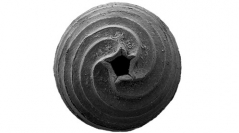

 Geodiversitas
40 (10) - Pages 195-209
Geodiversitas
40 (10) - Pages 195-209Neogene lacustrine deposits in Zahle, western margin of the Bekaa Valley (Lebanon), are studied from a biostratigraphic and paleoenvironmental point of view using fossil charophytes. These sediments contain a well-preserved charophyte assemblage described and illustrated here for the first time including the taxa: Nitellopsis (Tectochara) merianii Grambast & Soulié-Märsche, 1972, Lychnothamnus barbatus var. antiquus Soulié-Märsche, 1989, Chara aff. microcera Grambast & Paul, 1965 and Chara sp. Nitellopsis (T.) merianii has been reported in several European and Asiatic localities ranging in age from Late Eocene to Pliocene, L. barbatus var. antiquus has been found in several European Miocene localities in Europe and Turkey, while Chara aff. microcera has been documented from a large number of west European localities ranging in age from Early Oligocene to Early Miocene. Based on these data, we inferred that the basal part of the lacustrine deposits of Zahle is lower Miocene in age which is consistent with isotopic results obtained from basalts located northern, laterally and above the lacustrine sequence of Zahle. The palaeoenvironmental characteristics at the base of these deposits are inferred by comparing of the occurrence of N. (T.) merianii and L. barbatus var. antiquus with the ecological requirements of their nearest living relatives (Nitellopsis obtusa and Lychnothamnus barbatus). This suggests that the Bekaa Valley was occupied by a permanent, shallow oligotrophic freshwater lake during the Miocene. This study also provides valuable data about the palaeogeographic distribution of Neogene charophyte from Lebanon and the Middle East region.
Charophyta, Bekaa Valley, Neogene, Miocene, biostratigraphy, palaeoecology